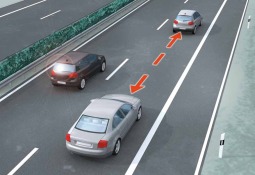Lasers and infrared LEDs for self-driving cars
More than ten years ago, Osram Opto Semiconductors supplied infrared laser diodes for the first laser sensors in cars. As one of the first suppliers of powerful infrared LEDs (IREDs), Osram has also accompanied the development of camera systems with additional infrared illumination since their inception. Up to now, these optical sensors have been connected to one assistance system each, but from now on they will play an important role in automated driving in combination with other technologies. With the help of the optical sensors, the self-driving car captures its surroundings, and makes decisions using the data it has gathered.
Powerful laser diodes for LIDAR sensors
LIDAR sensors (LIDAR – Light Detection And Ranging) register objects in their surroundings, and capture their distance to the sensor. For that to happen, a laser emits a very short light pulse, and a fast detector measures the time that the light needs to travel from the sensor to the object and back. The movement of the object relative to the car results from the propagation time of the signal. Today, LIDAR sensors are used for adaptive cruise control systems and emergency braking assistance, among others. Important criteria for the laser light sources are their output in pulsed mode to achieve long ranges, short switching times, and their suitability for use in cars. For LIDAR sensors in cars, Osram has developed infrared pulse laser diodes with a wavelength of 905 nanometers (nm), which is not visible to the human eye. Laser chips with three emission centers which provide more than 75 watts of optical pulse power were created using nanostack technology. An integrated driver circuit inside the SPL LL90_3 laser diode allows pulse durations of about 20 nanoseconds.
 |
Fast infrared pulse laser diodes are the basis of LIDAR sensors which capture the distance of objects to the car. So far, this technology has been used in assistance systems such as adaptive cruise control systems. In future it will play a key role in the development of self-driving cars. (Osram/LEDinside)
|
Record IRED for camera systems
Camera systems provide images and videos from which information on the surroundings can be extracted with the help of intelligent image processing. If the scene is also illuminated with infrared light, which is registered by camera sensors, but is hardly visible to the human eye, the image quality at night can be considerably improved. Night vision assistants which illuminate streets with infrared light over a distance of about 150 meters are a good example. The systems require powerful IREDs with a suitable wavelength, which are fit for continuous operation. Osram Opto Semiconductors currently holds the IRED record with a wavelength of 850 nm. The Oslon Black SFH 4715A delivers an optical output of around 800 milliwatts (mW) from a current of 1 A, and at 48 percent it is currently the most efficient IRED under these operating conditions. Using stacked chips with two emitters each will result in even higher values. That is how the Oslon Black SFH 4715AS achieves 1370 mW at 1 A in continuous operation.
Not losing sight of the driver
Applications in the interior of cars also benefit from these developments. One example is the detection of the driver's alertness with the help of cameras. An automatically controlled car requires this information to safely hand back control to the driver, if required. Camera systems inside cars require IREDs with a wavelength of 940 nm, which even at night is not visible to the human eye. Osram has upgraded the technology for its highly efficient 850 nm chips, and almost reaches the 1 watt mark with its 940 nm stacked chips – typically, an Oslon Black SFH 4725S delivers 990 mW at 1 A.
Generally, continuous development of light sources for optical sensors will play an important role on the road to automated traffic. The previously separate assistance systems will be merged into larger complete systems, changing the requirements that the separate sensors have to meet.












